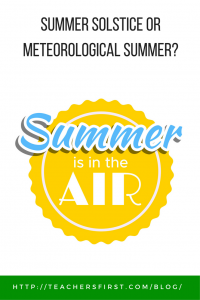 Summer officially begins on June 21 at 12:24 AM EST. Or does it? Ask your local weatherman and he will probably say that meteorological summer began on June 1. Both explanations, based on data and science, offer interesting opportunities for exploring weather and seasons through a different perspective.
Summer officially begins on June 21 at 12:24 AM EST. Or does it? Ask your local weatherman and he will probably say that meteorological summer began on June 1. Both explanations, based on data and science, offer interesting opportunities for exploring weather and seasons through a different perspective.
To understand the difference between the two explanations, visit NOAA and Weather.com to learn about the difference in each theory. Earth’s position relative to the sun determines astronomical seasons (June 21). Using astronomical data, the starting date of summer will vary each year based on the earth’s revolution around the sun. On the other hand, average temperature data determines meteorological seasons (June 1). This theory makes weather calculations easier for meteorologists to calculate statistics based on using a calendar month instead of different dates each year. In fact, it probably makes sense to a lot of us considering that we experience summer temperatures well before the official start of the season on June 21.
Virtually all information available for teaching and learning about seasons uses the astronomical calendar. A keyword search for seasons on TeachersFirst results in over 60 resources for exploring the seasons in all grade levels. Many of these include lesson plans or interactive websites for exploring the seasons.
This difference in defining seasons creates opportunities for classroom or at-home explorations and discussions. If your school is out for the summer, here are some suggestions for your lessons on seasons when returning to the classroom.
- Contact your local tv station or weather service to schedule a visit from a meteorologist. Ask them to discuss the differences between astrological and meteorological seasons and how they address them in their work.
- Graph your temperatures during the month that the season changes and compare early month temperatures to those later in the month as the season “officially” changes. This online chart tool makes it easy to create various types of graphs for sharing your results.
- Collaborate with another classroom on Skype to explore the change in seasons in different parts of the world. Ideally, find a class that has different seasons from yours.
- After learning about seasons and the different approaches to defining them, have students debate which approach is the one they feel is best. Encourage conversations and discussions using one of my favorite tools, Flipgrid. Flipgrid allows each student to create a video sharing their thoughts; then others join the discussion to share their opinions.
Here are a few interactive websites and online resources that offer opportunities for students to explore seasons by observing the path of the earth around the sun and viewing how the tilt of the earth affects temperatures:
- The seasons interactive from McGraw-Hill allows users to move the earth around the sun at different speeds. As the earth moves, the display shows the path of movement, temperature changes, and the angle of sunlight.
- The University of Nebraska-Lincoln also offers a seasons simulator allowing users to drag the earth around the sun to view angles of the sun from the side and from the view of the sun. The timeline on the bottom correlates the earth’s movement to months of the year.
- Why Do We Have Seasons? from PBS provides an interactive along with classroom support materials correlated to science standards. In addition to viewing the earth’s orbit around the sun, the interactive contains additional information on seasons and the solstices.
- TeachersFirst’s CurriConnect Book List on Weather, Climate, and Atmosphere offers suggestions for weather-related books for kindergarten through young adult readers. Take advantage of this resource to stock your classroom library or prepare for a visit to your local library. After reading, discuss how seasons change and why scientists might classify the beginning of seasons differently.
Teaching about the weather is part of every science curriculum and one that students easily relate to. Bringing another perspective encourages students to think about weather and seasons through timely conversations and explorations of data.
What do you think about the different perspectives on the beginning of the solstice? Which one are you? A Meteorologic or Astronomic Solstice subscriber? Share your thoughts in the comments below.

